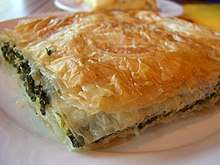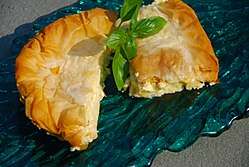Spanakopita
Spanakopita (/ˌspænəˈkɒpɪtə, -ˈkoʊ-/; Greek: σπανακόπιτα, from σπανάκι, spanáki, spinach, and πίτα, píta, pie) meaning "spinach pie", is a Greek savory pastry, typically with spinach and feta cheese filling.[1] It is similar to the börek pastry of other eastern Mediterranean cultures. Greeks have been eating these pies since ancient times. One of the earliest references to one comes from the poet Philoxenos in the fifth century B.C. Philoxenos writes that at the end of a banquet the hosts served a cheesecake made with milk and honey that was baked like a pie.
 Spanakopita | |
| Type | Savoury pie |
|---|---|
| Place of origin | Greece |
| Region or state | Southern Europe |
| Main ingredients | Phyllo, spinach (or leeks, chard, or sorrel), feta and/or ricotta, onions or Spring onions, eggs |
Ingredients and variations
The traditional filling comprises chopped spinach, feta cheese, onions or spring onions, egg, and seasoning.[2] Other white, preferably salted cheeses such as kefalotiri may also be mixed with the feta cheese, and some may be used as a substitute for feta cheese. Herbs such dill, mint and parsley as may be used as flavouring.[3] The filling is wrapped or layered in phyllo (filo) pastry with butter or olive oil, either in a large pan from which individual servings are cut, or rolled into individual triangular servings.[1] While the filo-dough recipe is most common, some recipes use a village-style pastry horiatiko, which has a thicker crust.[3] It can also be made with puff pastry. The pastry is golden in colour when baked, the colour often enhanced by butter and egg yolk. It can be served straight from the oven or at room temperature.
There is a "fasting" ("nistisimo"), or vegan, version of spanakopita, eaten during the Great Lent and other religious fasts. This version has spinach, onions or green onions, other green herbs like dill, parsley or celery, as filling, and uses olive oil and a little wheat flour but no eggs or dairy products. The mixture is oven-baked until crisp. Non-traditional vegan versions are available that typically use tofu instead of cheese.[4]
In rural Greece, smaller amounts of spinach are used, with the missing amount replaced with leeks, chard and sorrel.
Related pastries
Spanakopita appears in many traditional Greek cookery books and appears in numerous restaurants and hotel menus throughout Greece and internationally. The pastry is similar to torta pasqualina, a traditional dish from Italy's Liguria region, that is very common in Argentina and Uruguay, and to pita zeljanica (sometimes considered a kind of burek) popular in Serbia and Bosnia. It is also a common dish in Gibraltar where cheddar or edam may replace the feta.
See also
References
- Wright, Clifford (2003). The Little Foods of the Mediterranean: 500 Fabulous Recipes for Antipasti, Tapas, Hors D'Oeuvre, Meze, and More. Harvard Common Press. pp. 268–269. ISBN 978-1558322271.
- Zane, Eva (1992). Greek Cooking for the Gods. Santa Rosa, California: The Cole Group. ISBN 978-1-56426-501-2.
- Cloake, Felicity (22 August 2018). "How to make the perfect spanakopita". The Guardian.
- "Vegan Spanakopita (Greek Spinach & Feta Pie)". Vegan World. 7 May 2016.
